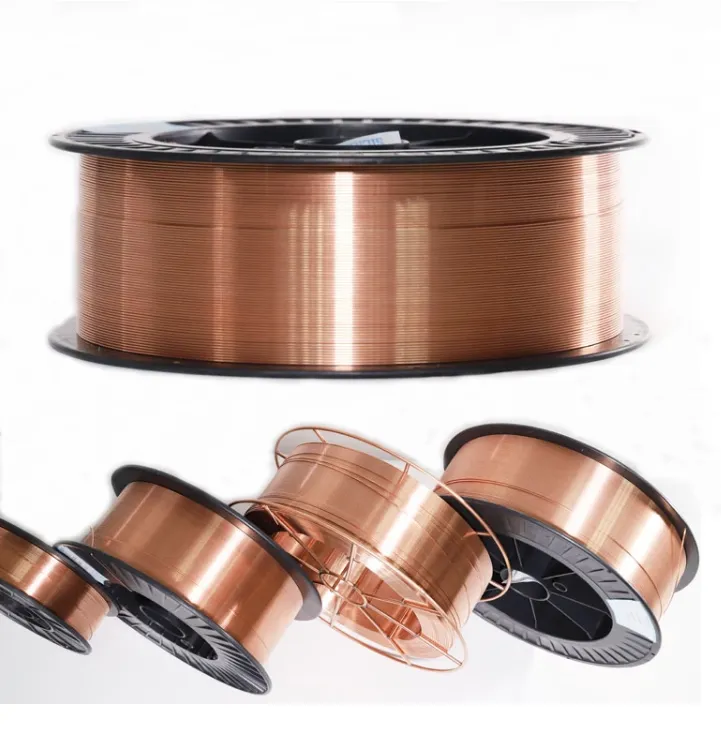Precision Welding with Copper Coated Mild Steel Wire
In today’s high-demand fabrication and construction industries, copper coated mild steel wire delivers unmatched welding efficiency, consistent results, and excellent mechanical performance. Designed for gas metal arc welding (GMAW), this wire type is a go-to choice for structural work, automotive production, and general engineering.
Copper coated mild steel wire offers a unique combination of smooth arc stability and high deposition rates. Its uniform copper coating improves conductivity and ensures a stable arc, which significantly reduces spatter and minimizes defects. The result is a stronger, cleaner weld with better aesthetics.
This wire is also easy to feed, making it ideal for semi-automated and fully automated welding systems. The copper coating acts as a protective layer against corrosion and oxidation, extending the shelf life and preserving weld integrity. It is widely used with CO₂ or Ar-CO₂ shielding gas blends and performs well across flat, horizontal, and vertical welding positions.

Cost-Effective Production with Copper Coated MS Wire
Manufacturers focused on quality and efficiency consistently turn to copper coated ms wire. It provides all the benefits of mild steel wire with the added advantage of copper coating. This layer significantly reduces friction during wire feeding and contributes to a cleaner and more precise welding process.
Copper coated ms wire is engineered for excellent feedability through long conduits, making it ideal for robotic welding operations. In addition, its low moisture absorption properties help prevent hydrogen-induced cracking—a critical factor when welding thicker sections of steel or when working in humid environments.
Available in a variety of diameters, copper coated ms wire accommodates diverse welding needs from light fabrication to heavy structural welding. Its versatility and affordability make it a staple material for high-volume welding shops and large-scale production plants seeking to reduce both downtime and material costs.
Eco-Friendly Alternatives: Copper Free Welding Wire
For companies seeking more sustainable solutions, copper free welding wire presents a viable alternative without compromising weld quality. This innovative product eliminates copper plating entirely, resulting in a cleaner production process and safer working conditions due to reduced copper fumes during welding.
Copper free welding wire features a specially formulated surface treatment that offers similar arc stability and feedability to copper-coated variants. In industries with strict environmental regulations or where cleanliness is a top priority—such as food equipment manufacturing or cleanroom fabrication—this type of wire becomes indispensable.
Additionally, copper free welding wire reduces tip wear in contact tips and linings, increasing equipment life and lowering maintenance costs. This not only cuts down on operating expenses but also improves overall system performance and reliability, especially in high-volume, automated welding lines.
mig copper wire for Consistent CO₂ Shielded Welding
Widely recognized for its performance in CO₂ gas shielded arc welding, mig copper wire provides an ideal balance of penetration, low spatter, and minimal porosity. It’s engineered for MIG welding applications across a broad range of metal thicknesses and joint configurations.
Mig copper wire is preferred by fabrication shops and field welders alike because of its high-speed performance and excellent wetting action. This ensures that each weld passes visual and structural integrity inspections with ease. The copper plating provides superior current transfer from the contact tip, which helps maintain a stable arc even under variable welding parameters.
This wire supports high deposition efficiency and has excellent bead appearance, making it ideal for applications where weld quality and appearance both matter. Additionally, mig copper wire is compatible with most standard wire feeders and contact tips, making integration into existing systems straightforward and hassle-free.
Understanding Copper Coated Welding Wire Specifications
When selecting the right product for your project, understanding copper coated welding wire specifications is key. These specifications determine how the wire performs under various welding conditions and include parameters such as tensile strength, chemical composition, diameter tolerance, and coating thickness.
Copper coated welding wire specifications often comply with industry standards such as AWS A5.18 for mild steel welding and ISO 14341. These standards ensure compatibility with shielding gases and equipment, while also guaranteeing mechanical strength, ductility, and impact resistance.
Knowing the exact copper coated welding wire specifications helps manufacturers choose the right wire for different base materials, welding positions, and joint types. For example, thinner wires are ideal for sheet metal and precision welding, while thicker wires deliver deep penetration in structural steel projects.
Specifications also cover packaging formats—spools, drums, or coils—to accommodate different welding volumes. Whether you are engaged in manual MIG welding or robotic welding lines, understanding wire specs ensures consistent performance and compliance with safety and quality standards.
copper coated mild steel wire FAQs
What makes copper coated mild steel wire better than uncoated wire?
The copper coating enhances conductivity, reduces spatter, and protects the wire from oxidation, resulting in cleaner welds and longer storage life.
Is copper coated ms wire suitable for robotic welding systems?
Yes, copper coated ms wire is widely used in robotic systems due to its excellent feedability and consistent arc performance.
What is the main benefit of using copper free welding wire?
Copper free welding wire offers an environmentally friendly alternative by eliminating copper fumes and reducing contact tip wear, making it ideal for clean production environments.
Where is mig copper wire typically used?
Mig copper wire is used in automotive manufacturing, construction, and heavy machinery industries for CO₂ gas shielded welding applications.
How can I select the right copper coated welding wire specifications?
Refer to AWS or ISO standards and consider factors such as base metal, joint design, welding position, and shielding gas to select the appropriate copper coated welding wire specifications for your application.
-
What is a medium-frequency pulse? What types of welding are suitable for?ข่าวNov.24,2025
-
Why is the overall cost of CO2 welding lower than that of shielded metal arc welding?ข่าวNov.21,2025
-
Welding Knowledge 6ข่าวNov.20,2025
-
What is a low-frequency pulse? What types of welding are they suitable for?ข่าวNov.19,2025
-
Why are the weld joints from CO₂ gas shielded welding of such high quality?ข่าวNov.18,2025
-
J506 Welding Rod - Low Hydrogen, All-Position, AC/DC E7016ข่าวNov.17,2025


